RMIT Financial Planning: Research and Application Assignment - Task 1
VerifiedAdded on 2022/11/28
|10
|2075
|356
Report
AI Summary
This report presents a comprehensive analysis of a financial planning assignment, covering key aspects of the financial services industry. It begins with an examination of the Financial Planning Association's (FPA) code of ethics, outlining its purpose, core principles, and methods for ensuring adherence. The report then explores the financial planning process, including budgeting and debt management strategies, and the advantages and risks associated with managed funds and share investments. It also delves into economic indicators impacting investments, client rapport-building techniques, and schedules for ongoing client services. The assignment draws on the provided materials, including the Swanston Banking Group Ltd. case study and relevant course modules, to provide practical insights and recommendations for financial planning practices. The report is structured around answering a series of questions related to financial planning concepts.
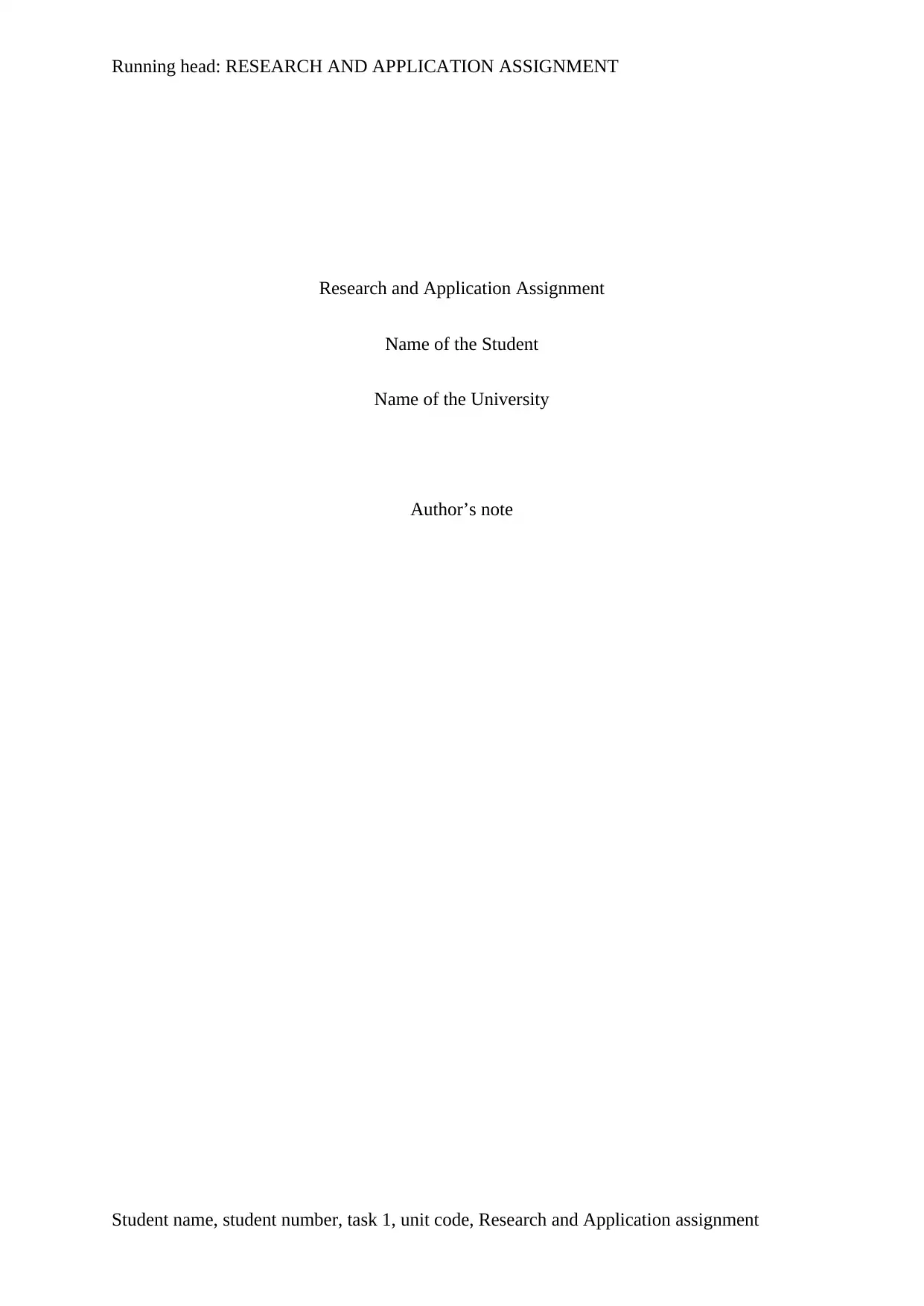
Running head: RESEARCH AND APPLICATION ASSIGNMENT
Research and Application Assignment
Name of the Student
Name of the University
Author’s note
Student name, student number, task 1, unit code, Research and Application assignment
Research and Application Assignment
Name of the Student
Name of the University
Author’s note
Student name, student number, task 1, unit code, Research and Application assignment
Paraphrase This Document
Need a fresh take? Get an instant paraphrase of this document with our AI Paraphraser
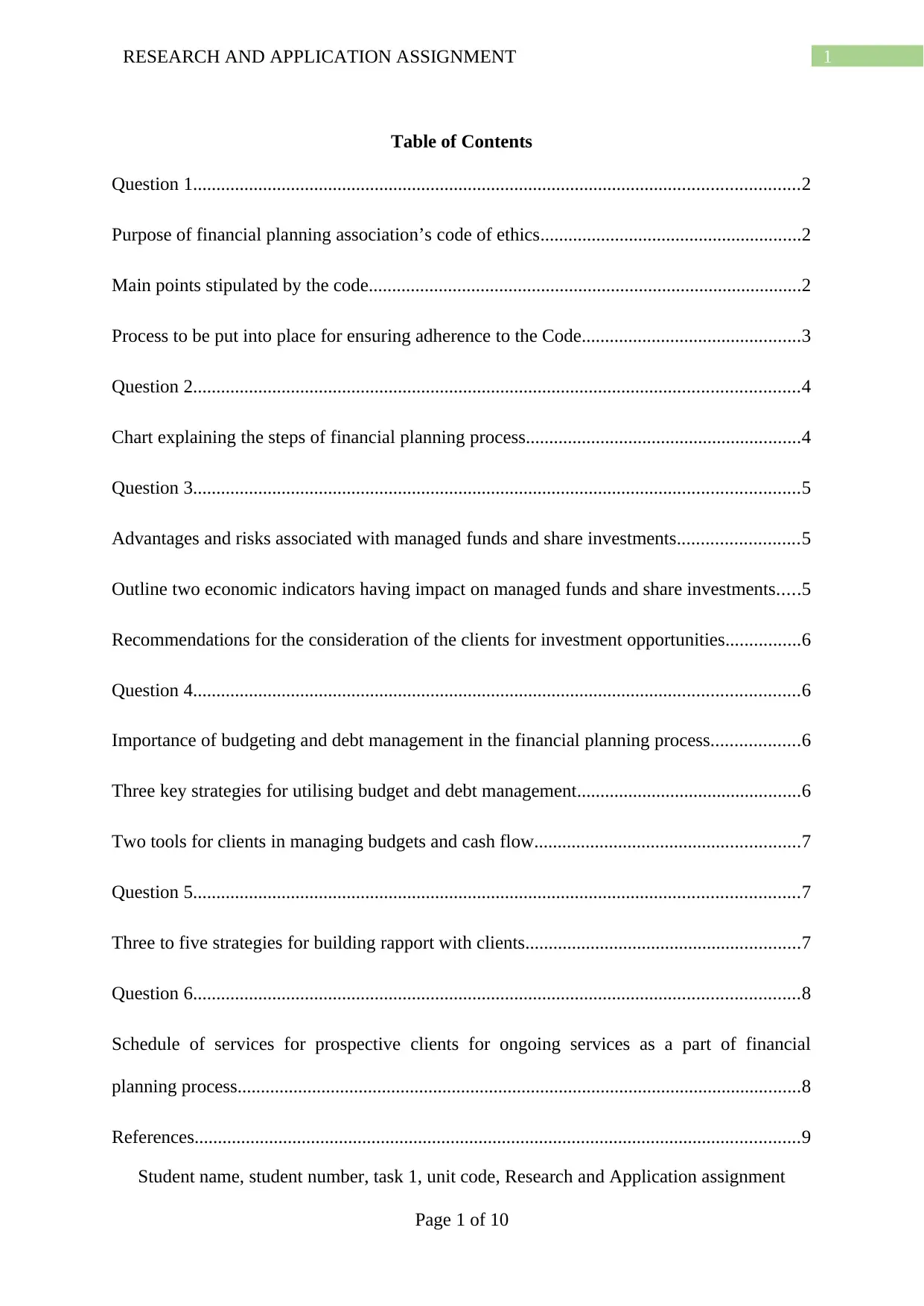
1RESEARCH AND APPLICATION ASSIGNMENT
Table of Contents
Question 1..................................................................................................................................2
Purpose of financial planning association’s code of ethics........................................................2
Main points stipulated by the code.............................................................................................2
Process to be put into place for ensuring adherence to the Code...............................................3
Question 2..................................................................................................................................4
Chart explaining the steps of financial planning process...........................................................4
Question 3..................................................................................................................................5
Advantages and risks associated with managed funds and share investments..........................5
Outline two economic indicators having impact on managed funds and share investments.....5
Recommendations for the consideration of the clients for investment opportunities................6
Question 4..................................................................................................................................6
Importance of budgeting and debt management in the financial planning process...................6
Three key strategies for utilising budget and debt management................................................6
Two tools for clients in managing budgets and cash flow.........................................................7
Question 5..................................................................................................................................7
Three to five strategies for building rapport with clients...........................................................7
Question 6..................................................................................................................................8
Schedule of services for prospective clients for ongoing services as a part of financial
planning process.........................................................................................................................8
References..................................................................................................................................9
Student name, student number, task 1, unit code, Research and Application assignment
Page 1 of 10
Table of Contents
Question 1..................................................................................................................................2
Purpose of financial planning association’s code of ethics........................................................2
Main points stipulated by the code.............................................................................................2
Process to be put into place for ensuring adherence to the Code...............................................3
Question 2..................................................................................................................................4
Chart explaining the steps of financial planning process...........................................................4
Question 3..................................................................................................................................5
Advantages and risks associated with managed funds and share investments..........................5
Outline two economic indicators having impact on managed funds and share investments.....5
Recommendations for the consideration of the clients for investment opportunities................6
Question 4..................................................................................................................................6
Importance of budgeting and debt management in the financial planning process...................6
Three key strategies for utilising budget and debt management................................................6
Two tools for clients in managing budgets and cash flow.........................................................7
Question 5..................................................................................................................................7
Three to five strategies for building rapport with clients...........................................................7
Question 6..................................................................................................................................8
Schedule of services for prospective clients for ongoing services as a part of financial
planning process.........................................................................................................................8
References..................................................................................................................................9
Student name, student number, task 1, unit code, Research and Application assignment
Page 1 of 10
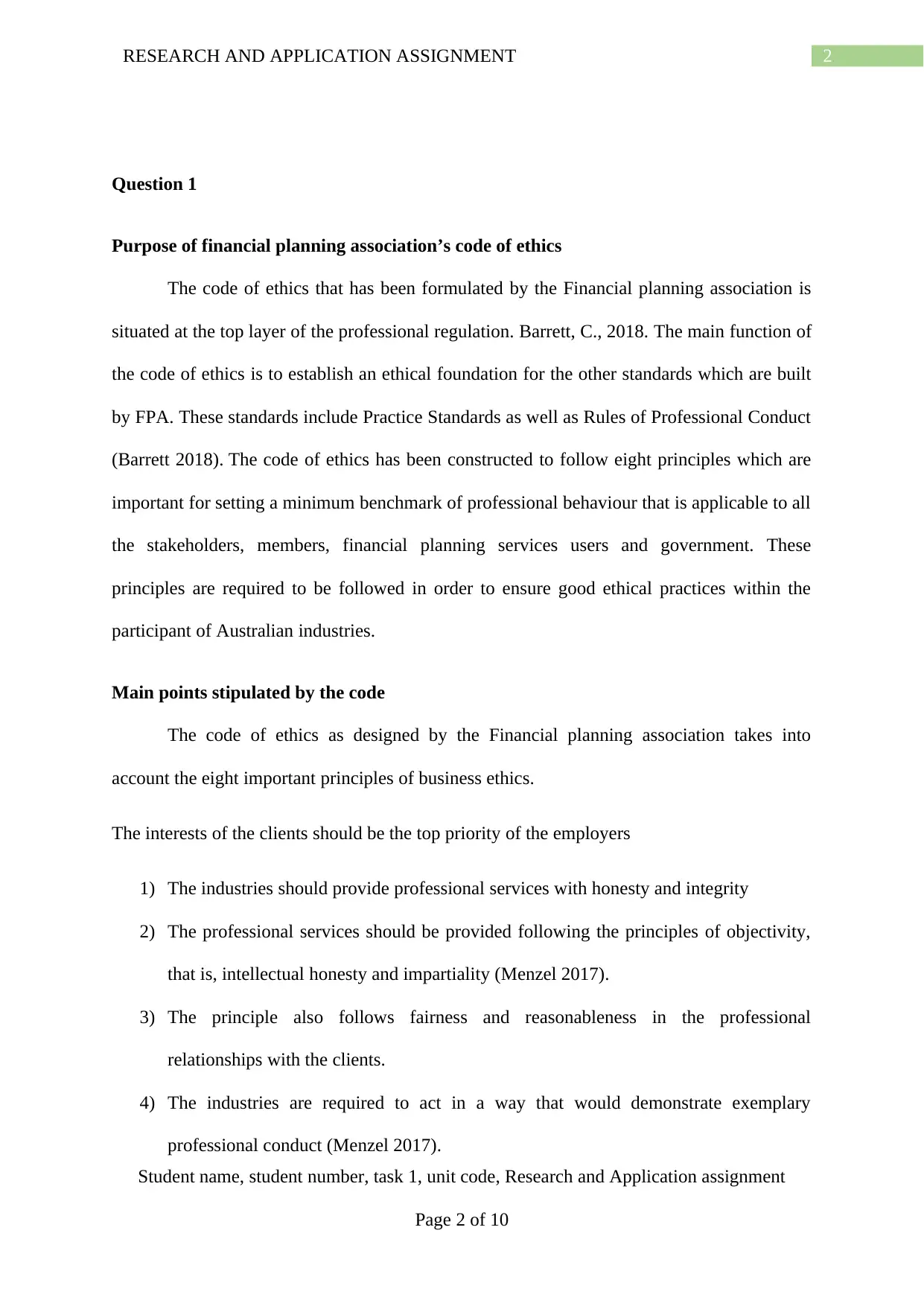
2RESEARCH AND APPLICATION ASSIGNMENT
Question 1
Purpose of financial planning association’s code of ethics
The code of ethics that has been formulated by the Financial planning association is
situated at the top layer of the professional regulation. Barrett, C., 2018. The main function of
the code of ethics is to establish an ethical foundation for the other standards which are built
by FPA. These standards include Practice Standards as well as Rules of Professional Conduct
(Barrett 2018). The code of ethics has been constructed to follow eight principles which are
important for setting a minimum benchmark of professional behaviour that is applicable to all
the stakeholders, members, financial planning services users and government. These
principles are required to be followed in order to ensure good ethical practices within the
participant of Australian industries.
Main points stipulated by the code
The code of ethics as designed by the Financial planning association takes into
account the eight important principles of business ethics.
The interests of the clients should be the top priority of the employers
1) The industries should provide professional services with honesty and integrity
2) The professional services should be provided following the principles of objectivity,
that is, intellectual honesty and impartiality (Menzel 2017).
3) The principle also follows fairness and reasonableness in the professional
relationships with the clients.
4) The industries are required to act in a way that would demonstrate exemplary
professional conduct (Menzel 2017).
Student name, student number, task 1, unit code, Research and Application assignment
Page 2 of 10
Question 1
Purpose of financial planning association’s code of ethics
The code of ethics that has been formulated by the Financial planning association is
situated at the top layer of the professional regulation. Barrett, C., 2018. The main function of
the code of ethics is to establish an ethical foundation for the other standards which are built
by FPA. These standards include Practice Standards as well as Rules of Professional Conduct
(Barrett 2018). The code of ethics has been constructed to follow eight principles which are
important for setting a minimum benchmark of professional behaviour that is applicable to all
the stakeholders, members, financial planning services users and government. These
principles are required to be followed in order to ensure good ethical practices within the
participant of Australian industries.
Main points stipulated by the code
The code of ethics as designed by the Financial planning association takes into
account the eight important principles of business ethics.
The interests of the clients should be the top priority of the employers
1) The industries should provide professional services with honesty and integrity
2) The professional services should be provided following the principles of objectivity,
that is, intellectual honesty and impartiality (Menzel 2017).
3) The principle also follows fairness and reasonableness in the professional
relationships with the clients.
4) The industries are required to act in a way that would demonstrate exemplary
professional conduct (Menzel 2017).
Student name, student number, task 1, unit code, Research and Application assignment
Page 2 of 10
⊘ This is a preview!⊘
Do you want full access?
Subscribe today to unlock all pages.

Trusted by 1+ million students worldwide
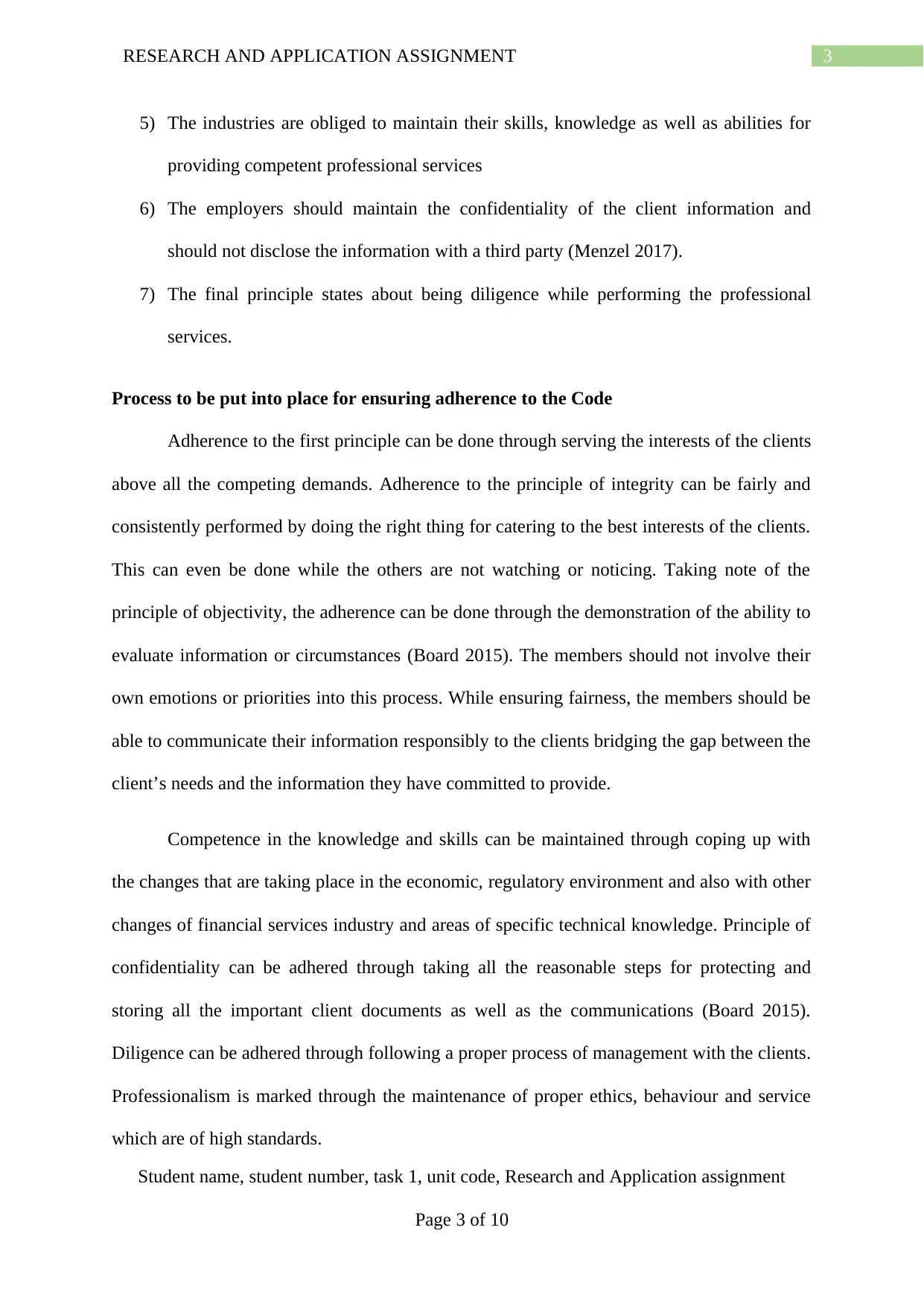
3RESEARCH AND APPLICATION ASSIGNMENT
5) The industries are obliged to maintain their skills, knowledge as well as abilities for
providing competent professional services
6) The employers should maintain the confidentiality of the client information and
should not disclose the information with a third party (Menzel 2017).
7) The final principle states about being diligence while performing the professional
services.
Process to be put into place for ensuring adherence to the Code
Adherence to the first principle can be done through serving the interests of the clients
above all the competing demands. Adherence to the principle of integrity can be fairly and
consistently performed by doing the right thing for catering to the best interests of the clients.
This can even be done while the others are not watching or noticing. Taking note of the
principle of objectivity, the adherence can be done through the demonstration of the ability to
evaluate information or circumstances (Board 2015). The members should not involve their
own emotions or priorities into this process. While ensuring fairness, the members should be
able to communicate their information responsibly to the clients bridging the gap between the
client’s needs and the information they have committed to provide.
Competence in the knowledge and skills can be maintained through coping up with
the changes that are taking place in the economic, regulatory environment and also with other
changes of financial services industry and areas of specific technical knowledge. Principle of
confidentiality can be adhered through taking all the reasonable steps for protecting and
storing all the important client documents as well as the communications (Board 2015).
Diligence can be adhered through following a proper process of management with the clients.
Professionalism is marked through the maintenance of proper ethics, behaviour and service
which are of high standards.
Student name, student number, task 1, unit code, Research and Application assignment
Page 3 of 10
5) The industries are obliged to maintain their skills, knowledge as well as abilities for
providing competent professional services
6) The employers should maintain the confidentiality of the client information and
should not disclose the information with a third party (Menzel 2017).
7) The final principle states about being diligence while performing the professional
services.
Process to be put into place for ensuring adherence to the Code
Adherence to the first principle can be done through serving the interests of the clients
above all the competing demands. Adherence to the principle of integrity can be fairly and
consistently performed by doing the right thing for catering to the best interests of the clients.
This can even be done while the others are not watching or noticing. Taking note of the
principle of objectivity, the adherence can be done through the demonstration of the ability to
evaluate information or circumstances (Board 2015). The members should not involve their
own emotions or priorities into this process. While ensuring fairness, the members should be
able to communicate their information responsibly to the clients bridging the gap between the
client’s needs and the information they have committed to provide.
Competence in the knowledge and skills can be maintained through coping up with
the changes that are taking place in the economic, regulatory environment and also with other
changes of financial services industry and areas of specific technical knowledge. Principle of
confidentiality can be adhered through taking all the reasonable steps for protecting and
storing all the important client documents as well as the communications (Board 2015).
Diligence can be adhered through following a proper process of management with the clients.
Professionalism is marked through the maintenance of proper ethics, behaviour and service
which are of high standards.
Student name, student number, task 1, unit code, Research and Application assignment
Page 3 of 10
Paraphrase This Document
Need a fresh take? Get an instant paraphrase of this document with our AI Paraphraser
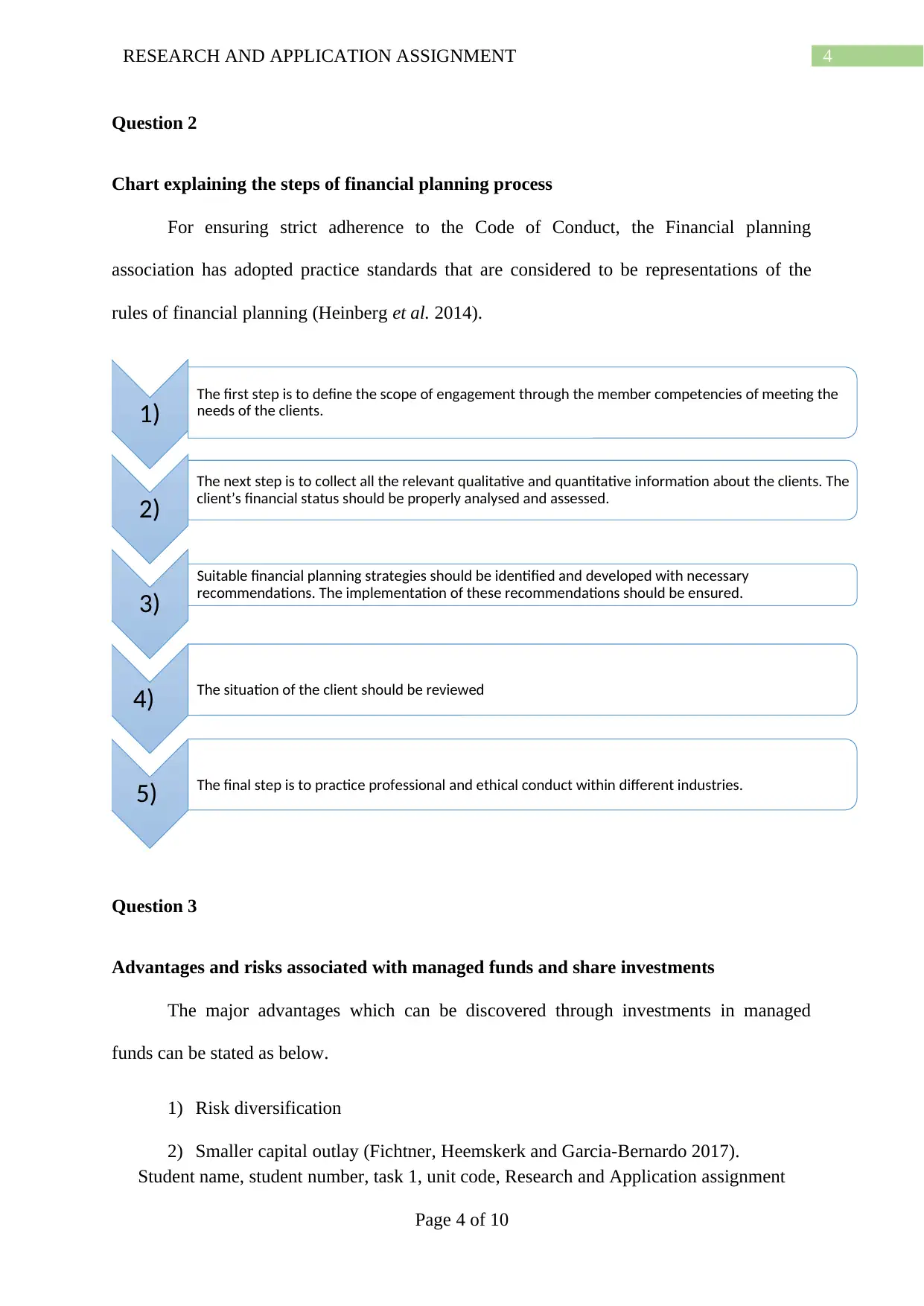
4RESEARCH AND APPLICATION ASSIGNMENT
Question 2
Chart explaining the steps of financial planning process
For ensuring strict adherence to the Code of Conduct, the Financial planning
association has adopted practice standards that are considered to be representations of the
rules of financial planning (Heinberg et al. 2014).
Question 3
Advantages and risks associated with managed funds and share investments
The major advantages which can be discovered through investments in managed
funds can be stated as below.
1) Risk diversification
2) Smaller capital outlay (Fichtner, Heemskerk and Garcia-Bernardo 2017).
Student name, student number, task 1, unit code, Research and Application assignment
Page 4 of 10
1) The first step is to define the scope of engagement through the member competencies of meeting the
needs of the clients.
2)
The next step is to collect all the relevant qualitative and quantitative information about the clients. The
client’s financial status should be properly analysed and assessed.
3)
Suitable financial planning strategies should be identified and developed with necessary
recommendations. The implementation of these recommendations should be ensured.
4) The situation of the client should be reviewed
5) The final step is to practice professional and ethical conduct within different industries.
Question 2
Chart explaining the steps of financial planning process
For ensuring strict adherence to the Code of Conduct, the Financial planning
association has adopted practice standards that are considered to be representations of the
rules of financial planning (Heinberg et al. 2014).
Question 3
Advantages and risks associated with managed funds and share investments
The major advantages which can be discovered through investments in managed
funds can be stated as below.
1) Risk diversification
2) Smaller capital outlay (Fichtner, Heemskerk and Garcia-Bernardo 2017).
Student name, student number, task 1, unit code, Research and Application assignment
Page 4 of 10
1) The first step is to define the scope of engagement through the member competencies of meeting the
needs of the clients.
2)
The next step is to collect all the relevant qualitative and quantitative information about the clients. The
client’s financial status should be properly analysed and assessed.
3)
Suitable financial planning strategies should be identified and developed with necessary
recommendations. The implementation of these recommendations should be ensured.
4) The situation of the client should be reviewed
5) The final step is to practice professional and ethical conduct within different industries.
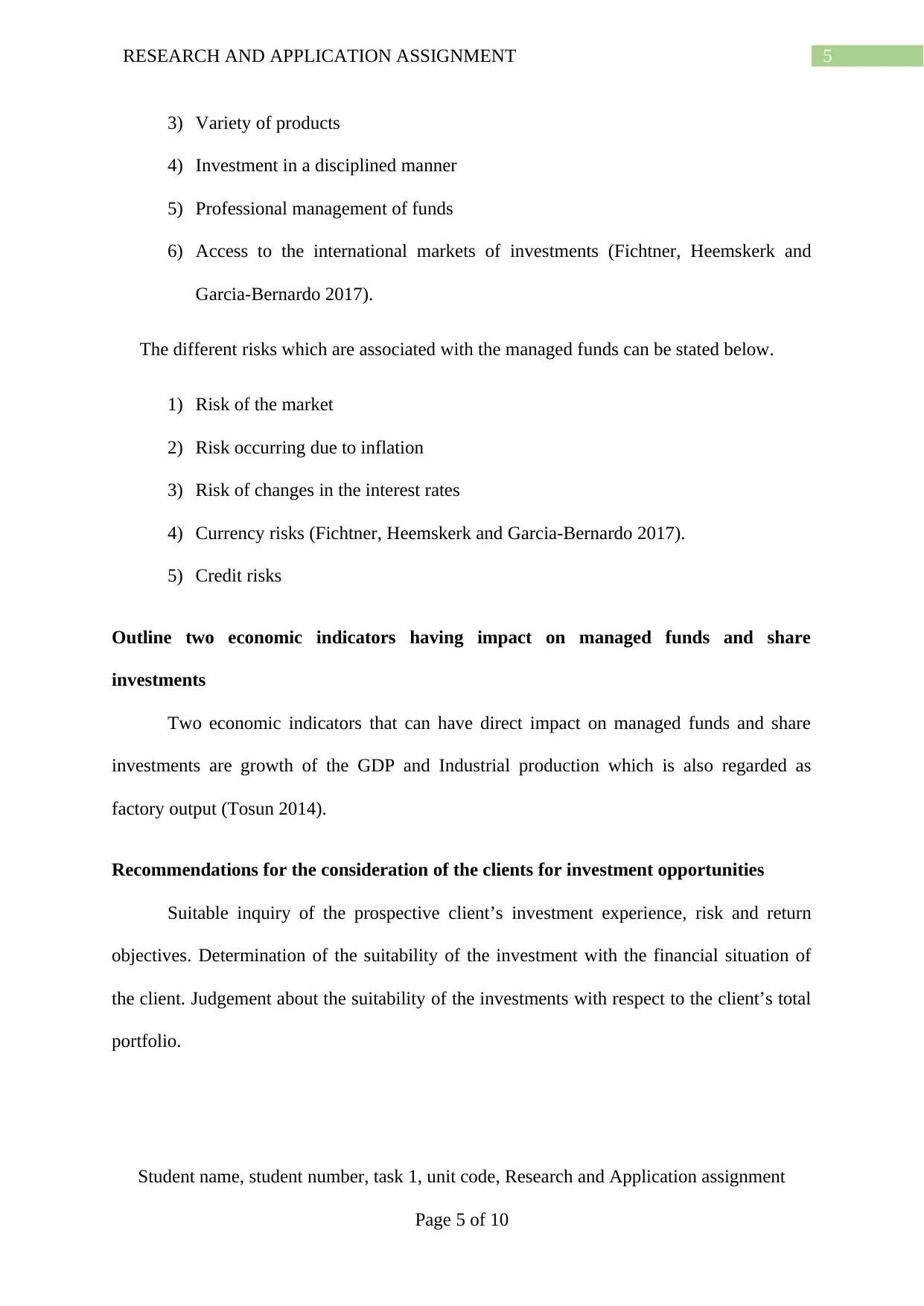
5RESEARCH AND APPLICATION ASSIGNMENT
3) Variety of products
4) Investment in a disciplined manner
5) Professional management of funds
6) Access to the international markets of investments (Fichtner, Heemskerk and
Garcia-Bernardo 2017).
The different risks which are associated with the managed funds can be stated below.
1) Risk of the market
2) Risk occurring due to inflation
3) Risk of changes in the interest rates
4) Currency risks (Fichtner, Heemskerk and Garcia-Bernardo 2017).
5) Credit risks
Outline two economic indicators having impact on managed funds and share
investments
Two economic indicators that can have direct impact on managed funds and share
investments are growth of the GDP and Industrial production which is also regarded as
factory output (Tosun 2014).
Recommendations for the consideration of the clients for investment opportunities
Suitable inquiry of the prospective client’s investment experience, risk and return
objectives. Determination of the suitability of the investment with the financial situation of
the client. Judgement about the suitability of the investments with respect to the client’s total
portfolio.
Student name, student number, task 1, unit code, Research and Application assignment
Page 5 of 10
3) Variety of products
4) Investment in a disciplined manner
5) Professional management of funds
6) Access to the international markets of investments (Fichtner, Heemskerk and
Garcia-Bernardo 2017).
The different risks which are associated with the managed funds can be stated below.
1) Risk of the market
2) Risk occurring due to inflation
3) Risk of changes in the interest rates
4) Currency risks (Fichtner, Heemskerk and Garcia-Bernardo 2017).
5) Credit risks
Outline two economic indicators having impact on managed funds and share
investments
Two economic indicators that can have direct impact on managed funds and share
investments are growth of the GDP and Industrial production which is also regarded as
factory output (Tosun 2014).
Recommendations for the consideration of the clients for investment opportunities
Suitable inquiry of the prospective client’s investment experience, risk and return
objectives. Determination of the suitability of the investment with the financial situation of
the client. Judgement about the suitability of the investments with respect to the client’s total
portfolio.
Student name, student number, task 1, unit code, Research and Application assignment
Page 5 of 10
⊘ This is a preview!⊘
Do you want full access?
Subscribe today to unlock all pages.

Trusted by 1+ million students worldwide
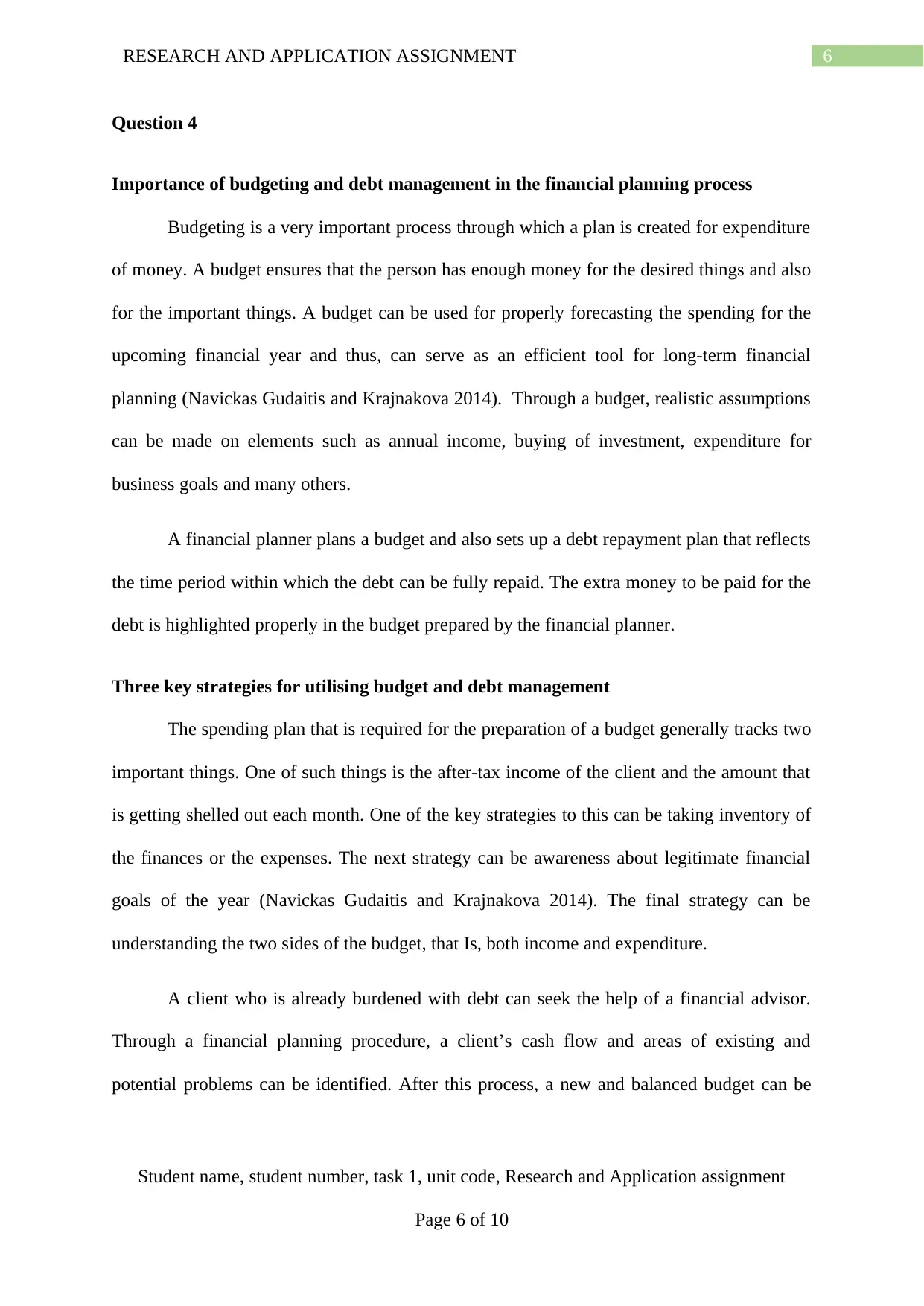
6RESEARCH AND APPLICATION ASSIGNMENT
Question 4
Importance of budgeting and debt management in the financial planning process
Budgeting is a very important process through which a plan is created for expenditure
of money. A budget ensures that the person has enough money for the desired things and also
for the important things. A budget can be used for properly forecasting the spending for the
upcoming financial year and thus, can serve as an efficient tool for long-term financial
planning (Navickas Gudaitis and Krajnakova 2014). Through a budget, realistic assumptions
can be made on elements such as annual income, buying of investment, expenditure for
business goals and many others.
A financial planner plans a budget and also sets up a debt repayment plan that reflects
the time period within which the debt can be fully repaid. The extra money to be paid for the
debt is highlighted properly in the budget prepared by the financial planner.
Three key strategies for utilising budget and debt management
The spending plan that is required for the preparation of a budget generally tracks two
important things. One of such things is the after-tax income of the client and the amount that
is getting shelled out each month. One of the key strategies to this can be taking inventory of
the finances or the expenses. The next strategy can be awareness about legitimate financial
goals of the year (Navickas Gudaitis and Krajnakova 2014). The final strategy can be
understanding the two sides of the budget, that Is, both income and expenditure.
A client who is already burdened with debt can seek the help of a financial advisor.
Through a financial planning procedure, a client’s cash flow and areas of existing and
potential problems can be identified. After this process, a new and balanced budget can be
Student name, student number, task 1, unit code, Research and Application assignment
Page 6 of 10
Question 4
Importance of budgeting and debt management in the financial planning process
Budgeting is a very important process through which a plan is created for expenditure
of money. A budget ensures that the person has enough money for the desired things and also
for the important things. A budget can be used for properly forecasting the spending for the
upcoming financial year and thus, can serve as an efficient tool for long-term financial
planning (Navickas Gudaitis and Krajnakova 2014). Through a budget, realistic assumptions
can be made on elements such as annual income, buying of investment, expenditure for
business goals and many others.
A financial planner plans a budget and also sets up a debt repayment plan that reflects
the time period within which the debt can be fully repaid. The extra money to be paid for the
debt is highlighted properly in the budget prepared by the financial planner.
Three key strategies for utilising budget and debt management
The spending plan that is required for the preparation of a budget generally tracks two
important things. One of such things is the after-tax income of the client and the amount that
is getting shelled out each month. One of the key strategies to this can be taking inventory of
the finances or the expenses. The next strategy can be awareness about legitimate financial
goals of the year (Navickas Gudaitis and Krajnakova 2014). The final strategy can be
understanding the two sides of the budget, that Is, both income and expenditure.
A client who is already burdened with debt can seek the help of a financial advisor.
Through a financial planning procedure, a client’s cash flow and areas of existing and
potential problems can be identified. After this process, a new and balanced budget can be
Student name, student number, task 1, unit code, Research and Application assignment
Page 6 of 10
Paraphrase This Document
Need a fresh take? Get an instant paraphrase of this document with our AI Paraphraser
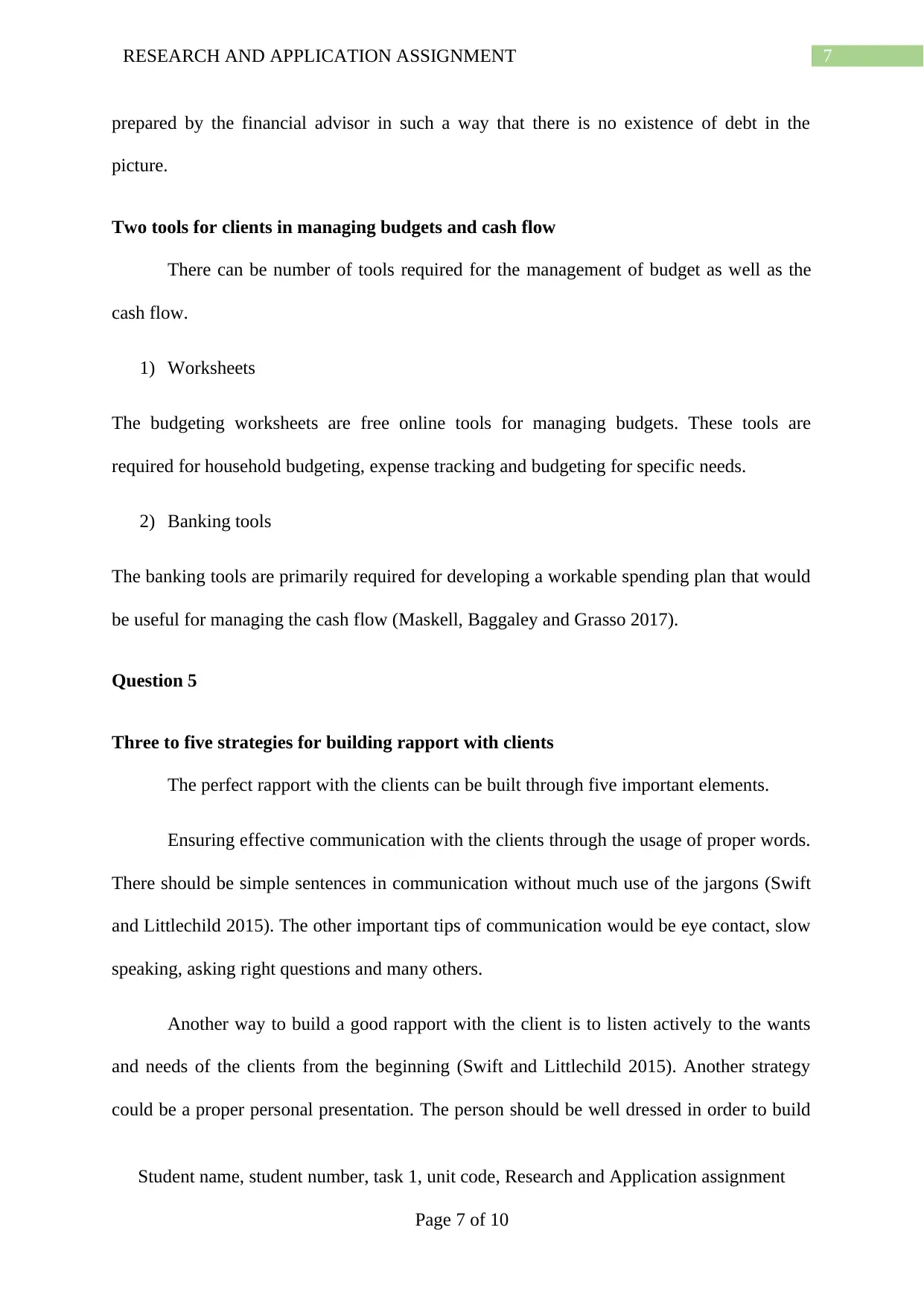
7RESEARCH AND APPLICATION ASSIGNMENT
prepared by the financial advisor in such a way that there is no existence of debt in the
picture.
Two tools for clients in managing budgets and cash flow
There can be number of tools required for the management of budget as well as the
cash flow.
1) Worksheets
The budgeting worksheets are free online tools for managing budgets. These tools are
required for household budgeting, expense tracking and budgeting for specific needs.
2) Banking tools
The banking tools are primarily required for developing a workable spending plan that would
be useful for managing the cash flow (Maskell, Baggaley and Grasso 2017).
Question 5
Three to five strategies for building rapport with clients
The perfect rapport with the clients can be built through five important elements.
Ensuring effective communication with the clients through the usage of proper words.
There should be simple sentences in communication without much use of the jargons (Swift
and Littlechild 2015). The other important tips of communication would be eye contact, slow
speaking, asking right questions and many others.
Another way to build a good rapport with the client is to listen actively to the wants
and needs of the clients from the beginning (Swift and Littlechild 2015). Another strategy
could be a proper personal presentation. The person should be well dressed in order to build
Student name, student number, task 1, unit code, Research and Application assignment
Page 7 of 10
prepared by the financial advisor in such a way that there is no existence of debt in the
picture.
Two tools for clients in managing budgets and cash flow
There can be number of tools required for the management of budget as well as the
cash flow.
1) Worksheets
The budgeting worksheets are free online tools for managing budgets. These tools are
required for household budgeting, expense tracking and budgeting for specific needs.
2) Banking tools
The banking tools are primarily required for developing a workable spending plan that would
be useful for managing the cash flow (Maskell, Baggaley and Grasso 2017).
Question 5
Three to five strategies for building rapport with clients
The perfect rapport with the clients can be built through five important elements.
Ensuring effective communication with the clients through the usage of proper words.
There should be simple sentences in communication without much use of the jargons (Swift
and Littlechild 2015). The other important tips of communication would be eye contact, slow
speaking, asking right questions and many others.
Another way to build a good rapport with the client is to listen actively to the wants
and needs of the clients from the beginning (Swift and Littlechild 2015). Another strategy
could be a proper personal presentation. The person should be well dressed in order to build
Student name, student number, task 1, unit code, Research and Application assignment
Page 7 of 10
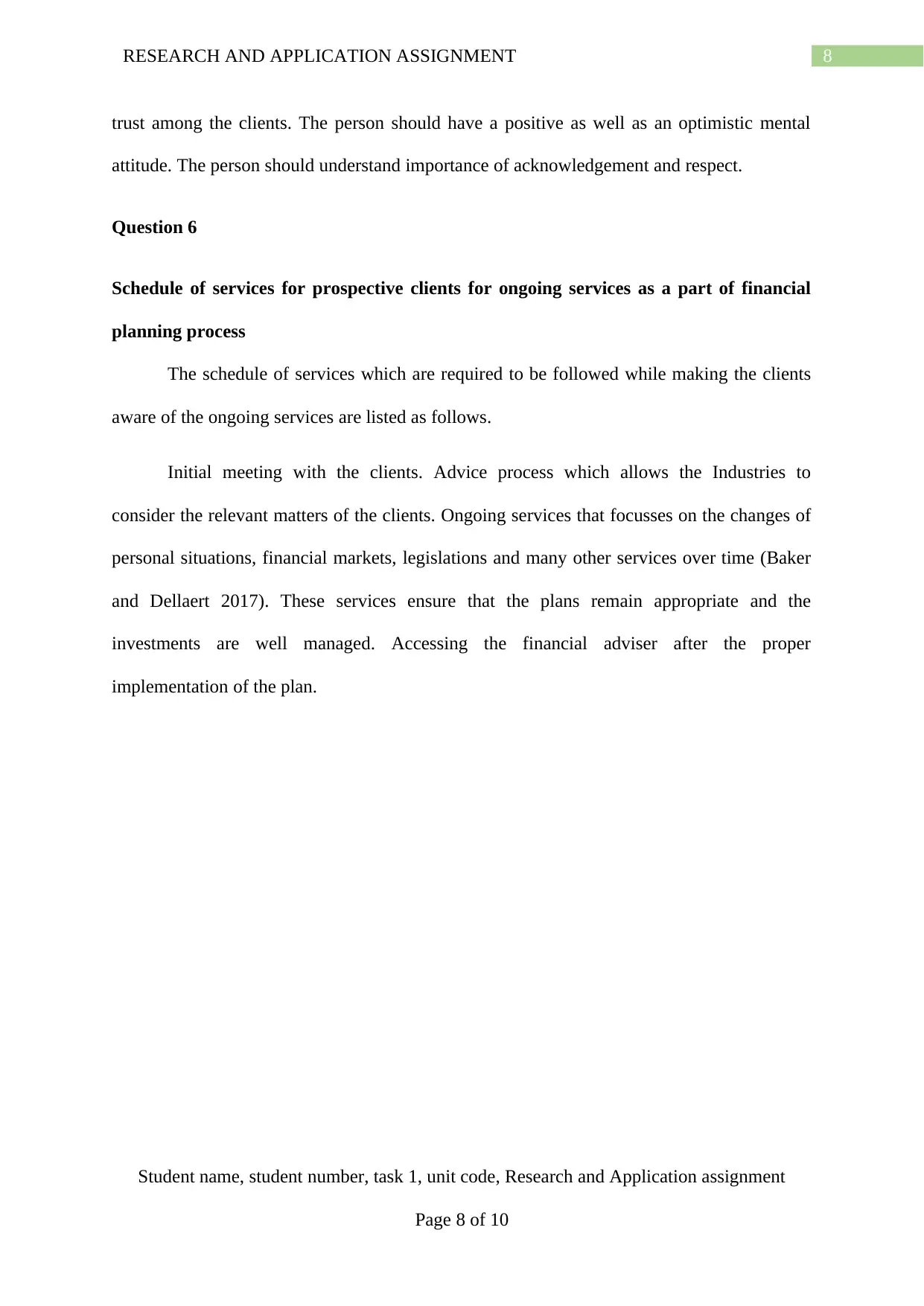
8RESEARCH AND APPLICATION ASSIGNMENT
trust among the clients. The person should have a positive as well as an optimistic mental
attitude. The person should understand importance of acknowledgement and respect.
Question 6
Schedule of services for prospective clients for ongoing services as a part of financial
planning process
The schedule of services which are required to be followed while making the clients
aware of the ongoing services are listed as follows.
Initial meeting with the clients. Advice process which allows the Industries to
consider the relevant matters of the clients. Ongoing services that focusses on the changes of
personal situations, financial markets, legislations and many other services over time (Baker
and Dellaert 2017). These services ensure that the plans remain appropriate and the
investments are well managed. Accessing the financial adviser after the proper
implementation of the plan.
Student name, student number, task 1, unit code, Research and Application assignment
Page 8 of 10
trust among the clients. The person should have a positive as well as an optimistic mental
attitude. The person should understand importance of acknowledgement and respect.
Question 6
Schedule of services for prospective clients for ongoing services as a part of financial
planning process
The schedule of services which are required to be followed while making the clients
aware of the ongoing services are listed as follows.
Initial meeting with the clients. Advice process which allows the Industries to
consider the relevant matters of the clients. Ongoing services that focusses on the changes of
personal situations, financial markets, legislations and many other services over time (Baker
and Dellaert 2017). These services ensure that the plans remain appropriate and the
investments are well managed. Accessing the financial adviser after the proper
implementation of the plan.
Student name, student number, task 1, unit code, Research and Application assignment
Page 8 of 10
⊘ This is a preview!⊘
Do you want full access?
Subscribe today to unlock all pages.

Trusted by 1+ million students worldwide
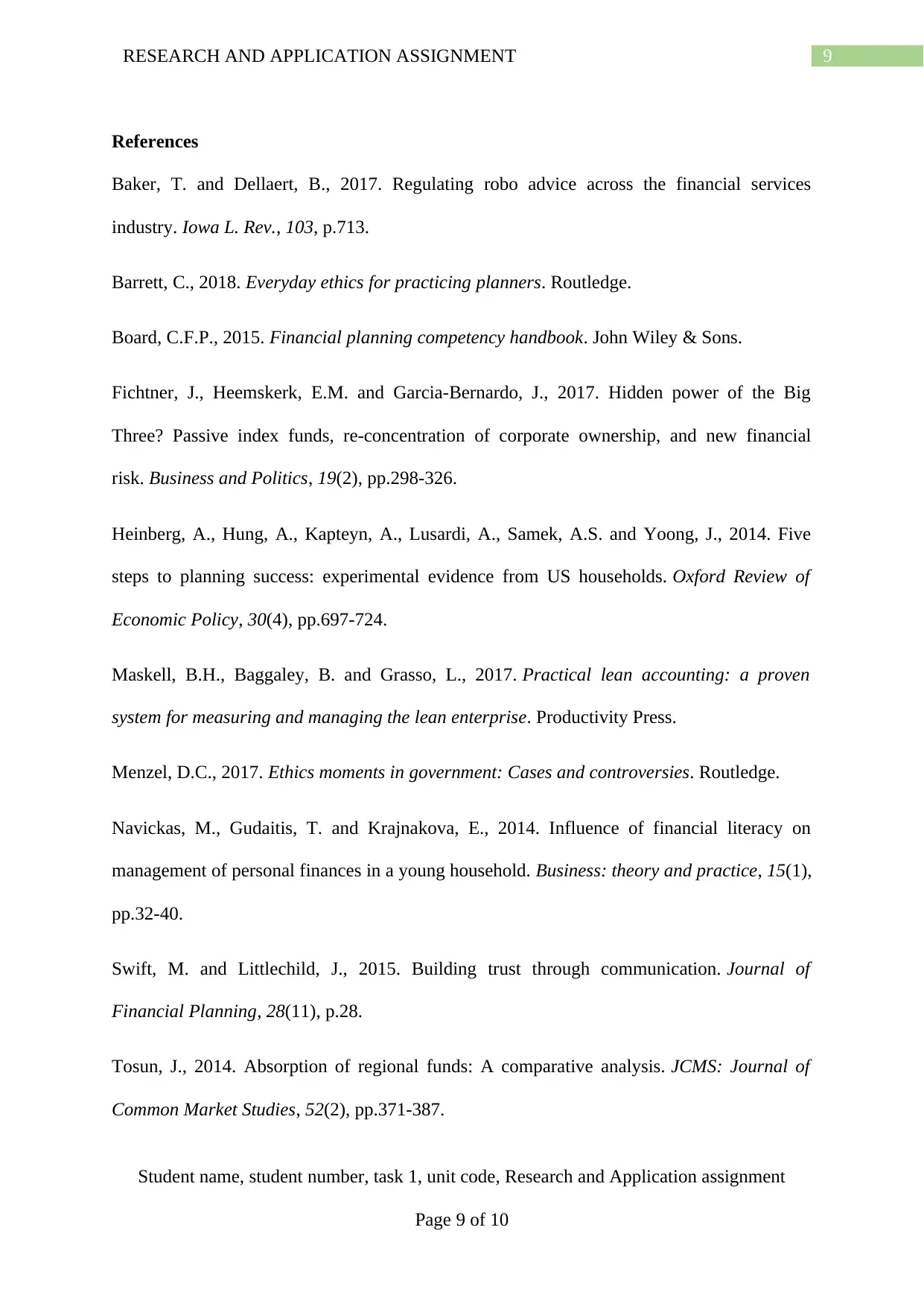
9RESEARCH AND APPLICATION ASSIGNMENT
References
Baker, T. and Dellaert, B., 2017. Regulating robo advice across the financial services
industry. Iowa L. Rev., 103, p.713.
Barrett, C., 2018. Everyday ethics for practicing planners. Routledge.
Board, C.F.P., 2015. Financial planning competency handbook. John Wiley & Sons.
Fichtner, J., Heemskerk, E.M. and Garcia-Bernardo, J., 2017. Hidden power of the Big
Three? Passive index funds, re-concentration of corporate ownership, and new financial
risk. Business and Politics, 19(2), pp.298-326.
Heinberg, A., Hung, A., Kapteyn, A., Lusardi, A., Samek, A.S. and Yoong, J., 2014. Five
steps to planning success: experimental evidence from US households. Oxford Review of
Economic Policy, 30(4), pp.697-724.
Maskell, B.H., Baggaley, B. and Grasso, L., 2017. Practical lean accounting: a proven
system for measuring and managing the lean enterprise. Productivity Press.
Menzel, D.C., 2017. Ethics moments in government: Cases and controversies. Routledge.
Navickas, M., Gudaitis, T. and Krajnakova, E., 2014. Influence of financial literacy on
management of personal finances in a young household. Business: theory and practice, 15(1),
pp.32-40.
Swift, M. and Littlechild, J., 2015. Building trust through communication. Journal of
Financial Planning, 28(11), p.28.
Tosun, J., 2014. Absorption of regional funds: A comparative analysis. JCMS: Journal of
Common Market Studies, 52(2), pp.371-387.
Student name, student number, task 1, unit code, Research and Application assignment
Page 9 of 10
References
Baker, T. and Dellaert, B., 2017. Regulating robo advice across the financial services
industry. Iowa L. Rev., 103, p.713.
Barrett, C., 2018. Everyday ethics for practicing planners. Routledge.
Board, C.F.P., 2015. Financial planning competency handbook. John Wiley & Sons.
Fichtner, J., Heemskerk, E.M. and Garcia-Bernardo, J., 2017. Hidden power of the Big
Three? Passive index funds, re-concentration of corporate ownership, and new financial
risk. Business and Politics, 19(2), pp.298-326.
Heinberg, A., Hung, A., Kapteyn, A., Lusardi, A., Samek, A.S. and Yoong, J., 2014. Five
steps to planning success: experimental evidence from US households. Oxford Review of
Economic Policy, 30(4), pp.697-724.
Maskell, B.H., Baggaley, B. and Grasso, L., 2017. Practical lean accounting: a proven
system for measuring and managing the lean enterprise. Productivity Press.
Menzel, D.C., 2017. Ethics moments in government: Cases and controversies. Routledge.
Navickas, M., Gudaitis, T. and Krajnakova, E., 2014. Influence of financial literacy on
management of personal finances in a young household. Business: theory and practice, 15(1),
pp.32-40.
Swift, M. and Littlechild, J., 2015. Building trust through communication. Journal of
Financial Planning, 28(11), p.28.
Tosun, J., 2014. Absorption of regional funds: A comparative analysis. JCMS: Journal of
Common Market Studies, 52(2), pp.371-387.
Student name, student number, task 1, unit code, Research and Application assignment
Page 9 of 10
1 out of 10
Related Documents
Your All-in-One AI-Powered Toolkit for Academic Success.
+13062052269
info@desklib.com
Available 24*7 on WhatsApp / Email
![[object Object]](/_next/static/media/star-bottom.7253800d.svg)
Unlock your academic potential
Copyright © 2020–2025 A2Z Services. All Rights Reserved. Developed and managed by ZUCOL.





